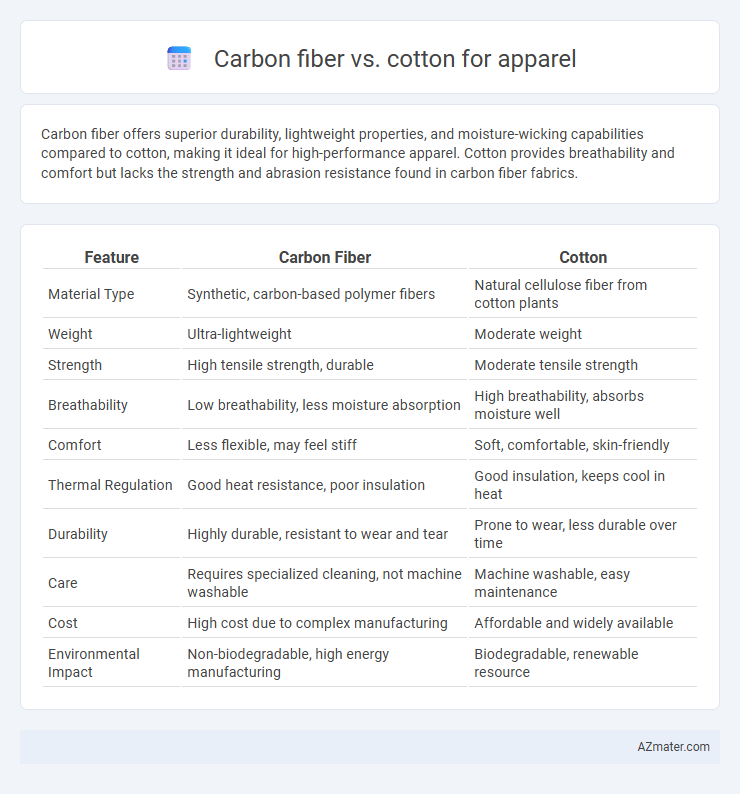Carbon fiber offers superior durability, lightweight properties, and moisture-wicking capabilities compared to cotton, making it ideal for high-performance apparel. Cotton provides breathability and comfort but lacks the strength and abrasion resistance found in carbon fiber fabrics.
Table of Comparison
| Feature | Carbon Fiber | Cotton |
|---|---|---|
| Material Type | Synthetic, carbon-based polymer fibers | Natural cellulose fiber from cotton plants |
| Weight | Ultra-lightweight | Moderate weight |
| Strength | High tensile strength, durable | Moderate tensile strength |
| Breathability | Low breathability, less moisture absorption | High breathability, absorbs moisture well |
| Comfort | Less flexible, may feel stiff | Soft, comfortable, skin-friendly |
| Thermal Regulation | Good heat resistance, poor insulation | Good insulation, keeps cool in heat |
| Durability | Highly durable, resistant to wear and tear | Prone to wear, less durable over time |
| Care | Requires specialized cleaning, not machine washable | Machine washable, easy maintenance |
| Cost | High cost due to complex manufacturing | Affordable and widely available |
| Environmental Impact | Non-biodegradable, high energy manufacturing | Biodegradable, renewable resource |
Introduction to Carbon Fiber and Cotton in Apparel
Carbon fiber in apparel offers exceptional strength-to-weight ratio, high durability, and resistance to stretching, making it ideal for performance and protective clothing. Cotton remains a popular textile due to its natural breathability, softness, and moisture absorption, ensuring comfort and ease of wear. The choice between carbon fiber and cotton impacts functionality and comfort, influencing thermal regulation, weight, and fabric longevity in garment applications.
Material Composition and Structure
Carbon fiber fabric features tightly woven strands of carbon atoms, offering exceptional tensile strength and lightweight durability, while cotton consists of natural cellulose fibers with a soft, breathable structure ideal for comfort. The molecular arrangement in carbon fiber provides high resistance to stretching and heat, making it suitable for performance apparel and protective gear. Cotton's fibrous, porous network absorbs moisture and allows ventilation, enhancing wearability for everyday clothing.
Durability and Strength Comparison
Carbon fiber exhibits superior durability and strength compared to cotton, making it an ideal choice for high-performance apparel requiring exceptional resistance to wear and tear. Cotton fibers, while breathable and comfortable, lack the tensile strength and abrasion resistance inherent in carbon fiber composites. This contrast positions carbon fiber as the preferred material in applications demanding long-lasting, robust clothing solutions.
Weight and Comfort Factors
Carbon fiber apparel offers exceptional lightweight properties, significantly reducing garment weight compared to traditional cotton fabrics, enhancing athletic performance and mobility. Cotton provides superior breathability and softness, ensuring comfort through natural moisture absorption and skin-friendly texture. While carbon fiber's rigidity may limit flexibility, its strength-to-weight ratio outperforms cotton, making it ideal for high-performance apparel requiring durability without bulk.
Thermal Regulation and Breathability
Carbon fiber fabrics excel in thermal regulation due to their superior heat resistance and ability to dissipate heat efficiently, making them ideal for high-performance apparel in extreme conditions. Cotton offers exceptional breathability and moisture absorption, providing natural cooling and comfort in everyday wear but lacks the advanced thermal management of carbon fiber. Performance apparel often blends carbon fiber with cotton to balance breathability with enhanced thermal regulation for versatile climate adaptability.
Moisture Management and Quick-Drying Properties
Carbon fiber fabrics excel in moisture management due to their high breathability and hydrophobic properties, efficiently wicking sweat away from the skin. Cotton, while soft and comfortable, retains moisture and dries slowly, making it less effective for activewear or high-performance apparel. Quick-drying carbon fiber blends enhance comfort by minimizing dampness and reducing the risk of chafing during prolonged physical activity.
Environmental Impact and Sustainability
Carbon fiber apparel offers exceptional durability and lightweight properties but poses significant environmental challenges due to energy-intensive manufacturing and difficulty in recycling, leading to increased carbon emissions. Cotton, as a natural fiber, is biodegradable and renewable but often requires substantial water usage, pesticides, and land resources, impacting soil health and biodiversity. Sustainable alternatives like organic cotton and recycled carbon fiber aim to reduce ecological footprints by minimizing chemical inputs and promoting circular economy practices.
Cost Analysis and Market Availability
Carbon fiber apparel commands a significantly higher price due to its advanced manufacturing processes and superior performance characteristics, making it less accessible to the average consumer. Cotton remains the dominant fabric in the apparel market because of its affordability and widespread availability, sourced from extensive global cotton farming industries. Market availability of cotton is vastly greater, while carbon fiber is primarily reserved for niche, high-end, or technical clothing applications where cost is less of a barrier.
Common Applications in Fashion and Sportswear
Carbon fiber is predominantly used in high-performance sportswear due to its exceptional strength-to-weight ratio and durability, making it ideal for compression garments and protective gear. Cotton remains a staple in everyday fashion and casual wear because of its breathability, softness, and natural moisture absorption, offering comfort for daily use. Sports apparel often combines carbon fiber elements with cotton to enhance flexibility and durability while maintaining comfort and breathability.
Future Trends in Apparel Material Innovation
Carbon fiber's integration into apparel is rapidly advancing due to its exceptional strength-to-weight ratio and durability, offering superior performance for athletic and protective wear. Emerging innovations focus on enhancing carbon fiber's flexibility and comfort to meet everyday clothing demands, driven by sustainable manufacturing techniques reducing environmental impact. Cotton remains vital for its breathability and comfort, but blending with carbon fiber and other smart textiles aims to create hybrid fabrics that optimize both functionality and eco-friendliness in future apparel trends.

Infographic: Carbon fiber vs Cotton for Apparel
 azmater.com
azmater.com